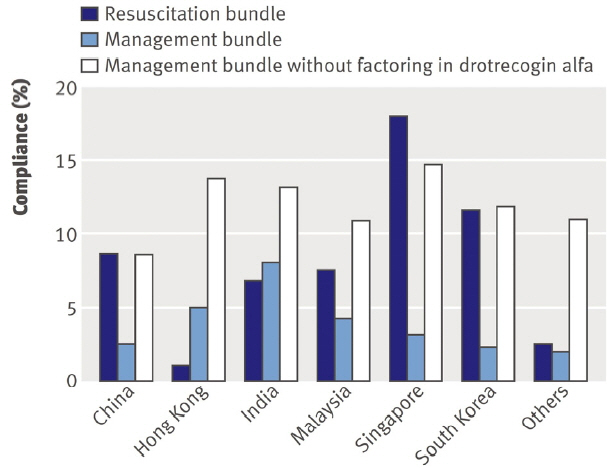Korean J Crit Care Med.
2014 Nov;29(4):246-249. 10.4266/kjccm.2014.29.4.246.
How to Enhance Critical Care in Korea: Challenges and Vision
- Affiliations
-
- 1Department of Pulmonary and Critical Care Medicine, Asan Medical Center, University of Ulsan College of Medicine, Seoul, Korea. yskoh@amc.seoul.kr
- KMID: 2227730
- DOI: http://doi.org/10.4266/kjccm.2014.29.4.246
Abstract
- The goal of critical care is to reverse patients' acute problems in effective and ethical ways with minimum costs. Unlike in other medical fields, the quality of Korean critical care has lagged behind that of advanced countries. Moreover, the level of critical care quality differs significantly between university hospitals. The suboptimal critical care level has multifactorial causes. The major challenge to Korean intensivists is, therefore, how to overcome barriers in the current critical care delivery system to improve outcomes for critically ill patients and reduce medical errors in error-prone Intensive Care Unit (ICUs). A long-term task force including all stakeholders should address the multifactorial barriers to better outcomes. The Korean Society of Critical Care Medicine should perform the central role to dismantle the barriers step by step with a long-term vision for a desirable critical care delivery system in our society. A capable critical care team with full-time intensivists is the most urgent requirement for proper, timely care in ICUs. Intensivists should focus on basic but essential management so scarcity of resources can be minimized. Publicity about ICU to the general public is also urgently required to draw the attention of medical policy makers to the current suboptimal level of our critical care system.
Keyword
MeSH Terms
Figure
Cited by 1 articles
-
Major Obstacles to Implement a Full-Time Intensivist in Korean Adult ICUs: a Questionnaire Survey
Jun Wan Lee, Jae Young Moon, Seok Wha Youn, Yong Sup Shin, Sang Il Park, Dong Chan Kim, Younsuk Koh
Korean J Crit Care Med. 2016;31(2):111-117. doi: 10.4266/kjccm.2016.31.2.111.
Reference
-
References
1). Kim JH, Hong SK, Kim KC, Lee MG, Lee KM, Jung SS, et al. Influence of full-time intensivist and the nurse-to-patient ratio on the implementation of severe sepsis bundles in Korean intensive care units. J Crit Care. 2012; 27:414.
Article2). Wunsch H, Angus DC, Harrison DA, Collange O, Fowler R, Hoste EA, et al. Variation in critical care services across North America and Western Europe. Crit Care Med. 2008; 36:2787–93.
Article3). Kwak SH, Jeong CW, Lee SH, Lee HJ, Koh Y. Current status of intensive care units registered as critical care subspecialty training hospitals in Korea. J Korean Med Sci. 2014; 29:431–7.
Article4). Stone PW, Mooney-Kane C, Larson EL, Horan T, Glance LG, Zwanziger J, et al. Nurse working conditions and patient safety outcomes. Med Care. 2007; 45:571–8.
Article5). Cho SH, Hwang JH, Kim J. Nurse staffing and patient mortality in intensive care units. Nurs Res. 2008; 57:322–30.
Article6). Sales A, Sharp N, Li YF, Lowy E, Greiner G, Liu CF, et al. The association between nursing factors and patient mortality in the Veterans Health Administration: the view from the nursing unit level. Med Care. 2008; 46:938–45.7). Blot SI, Serra ML, Koulenti D, Lisboa T, Deja M, Myrianthefs P, et al. Patient to nurse ratio and risk of ventilator-associated pneumonia in critically ill patients. Am J Crit Care. 2011; 20:e1–9.
Article8). Hugonnet S1, Uçkay I, Pittet D. Staffing level: a determinant of late-onset ventilator-associated pneumonia. Crit Care. 2007; 11:R80.
Article9). Bray K, Wren I, Baldwin A, St Ledger U, Gibson V, Goodman S, et al. Standards for nurse staffing in critical care units determined by: The British Association of Critical Care Nurses, The Critical Care Networks National Nurse Leads, Royal College of Nursing Critical Care and In-flight Forum. Nurs Crit Care. 2010; 15:109–11.
Article10). Hartigan RC. The Synergy Model. Establishing criteria for 1:1 staffing ratios. Crit Care Nurse. 2000; 20:112114–6.
Article11). Sirio CA, Tajimi K, Taenaka N, Ujike Y, Okamoto K, Katsuya H. A cross-cultural comparison of critical care delivery: Japan and the United States. Chest. 2002; 121:539–48.12). Mallick R, Strosberg M, Lambrinos J, Groeger JS. The intensive care unit medical director as manager. Impact on performance. Med Care. 1995; 33:611–24.
Article13). Phua J, Koh Y, Du B, Tang YQ, Divatia JV, Tan CC, et al. Management of severe sepsis in patients admitted to Asian intensive care units: prospective cohort study. BMJ. 2011; 342:d3245.
Article14). Berenholtz SM, Dorman T, Ngo K, Pronovost PJ. Qualitative review of intensive care unit quality indicators. J Crit Care. 2002; 17:1–12.
Article
- Full Text Links
- Actions
-
Cited
- CITED
-
- Close
- Share
- Similar articles
-
- Research on the Perceptions of Low Vision Rehabilitation
- Current challenges in adopting machine learning to critical care and emergency medicine
- Challenges to Overcome Barriers against Successful Implementation of Rapid Response Systems
- Advances and utility of digital twins in critical care and acute care medicine: a narrative review
- Critical Care Research Using “Big Dataâ€: A Reality in the Near Future


